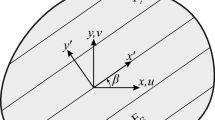Abstract
This contribution focuses on the theoretical development of the method of caustics and its applicability to anisotropic materials. The method displays its full power when employed in conjunction with interactive numerical data reduction and evaluation procedures. For the analysis the selection of data points along the experimentally recorded caustic curve is done automatically, the selected points are marked on the screen and if necessary interactive correction of the positions is possible. Final proof of the correctness of the result of the automatic data point selection is achieved by comparing for acceptable coincidence the numerically generated caustic determined on the basis of the results of the data-reduction technique with the experimentally recorded caustic.
Similar content being viewed by others
Abbreviations
- f(x, y) :
-
deformed surface
- \(\vec \nabla f(x, y)\) :
-
gradient of the deformed surface
- S(x, y, z) :
-
wave front
- Δs(x, y) :
-
change of optical path length
- x, y, z :
-
coordinates
- \(\vec X, \vec x\) :
-
vectorial representation of points at the screen plane, model plane
- Re(...),Im(...):
-
real, imaginary part of a complex variable
- \(\gamma _{xy} , \gamma _{yz} , \gamma _{zx}\) :
-
shearing-strain components
- \(\varepsilon _x , \varepsilon _y , \varepsilon _z\) :
-
normal-strain components
- μ:
-
mixed-mode ratio
- \(\sigma _x , \sigma _y , \sigma _z\) :
-
normal-stress components
- \(\tau _{xy} , \tau _{yz} , \tau _{zx}\) :
-
shearing-stress components
References
Manogg, P., “Anwendung der Schattenoptik zur Untersuchung des Zerreißvorganges von Platten,”PhD Thesis, Universität Freiburg i. Br., Freiburg, Germany (1964).
Manogg, P., “Investigation of the Rupture of a Plexiglas Plate by Means of an Optical Method Involving High Speed Filming of the Shadows Originating Around Holes Drilling in the Plate,”Int. J. Fract. Mech.,2,604–613 (1966).
Theocaris, P.S. andGdoutos, E., “An Optical Method for Determining Opening Mode and Edge Sliding Mode Stress-intensity Factors,”J. Appl. Mech.,39,91–97 (1972).
Special issues on: “The Optical Method of Caustics I, II,” Optics and Lasers in Engineering, ed. A.J. Rosakis, Elsevier Applied Science,13 (1990) and 14 (1991).
Kalthoff, J.F., “The Shadow Optical Methods of Caustics,” Handbook on Experimental Mechanics, Prentice Hall, Inc., Chap. 9. 430–500 (1987).
Rossmanith, H.P., “The Method of Caustics,”Advanced Photomechanics, ed. W.C. Wang, Dynamic Engineering Institute, National Tsing-Hua Univ., Hsinchu, Taiwan, 1–312 (1988).
Narasimhan, R. andRosakis, A.J., “A Finite Element Analysis of Small Scale Yielding near a Stationary Crack Under Plane Stress,”J. Mech. Phys. Solids,36,77 (1988).
Lekhnitskii, S.G., Theory of an Anisotropic Elastic Body, Holden-Day, San Francisco (1953).
Hoenig, A., Near-tip Behavior of a Crack in a Plane Anisotropic Elastic Body, Eng. Fract. Mech.,16 (3),393–403 (1982).
Semenski, D., “The Method of Caustics Applied to Mechanically Anisotropic Materials,”Master’s Thesis, Univ. of Zagreb, Zagreb, Croatia (1993).
Rossmanith, H.P., “The Method of Caustics for Static Plane Elasticity Problems,”J. Elasticity,12 (2),193–200 (1982).
Rossmanith, H.P., Knasmillner, R.E. andZhang, J., “Ein interaktives Verfahren zur Auswertung von Kaustiken an Rißspitzen in anisotropen Werkstoffen,”ÖAIZ,6 (136),210–213 (1991).
Rossmanith, H.P., Knasmillner, R.E. and Zhang, J., “Ein interaktives Verfahren zur Auswertung von Kaustiken an Trennflächenrissen,” Arch. of Appl. Mech., 115–122 (1992).
Author information
Authors and Affiliations
Rights and permissions
About this article
Cite this article
Rossmanith, H.P., Knasmillner, R.E. & Semenski, D. Crack-tip caustics in mechanically anisotropic materials. Experimental Mechanics 35, 31–35 (1995). https://doi.org/10.1007/BF02325831
Received:
Revised:
Issue Date:
DOI: https://doi.org/10.1007/BF02325831




